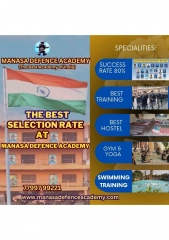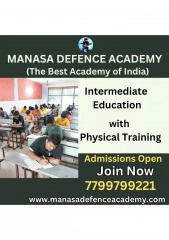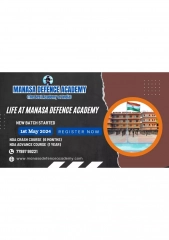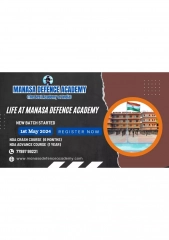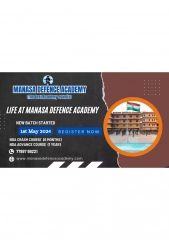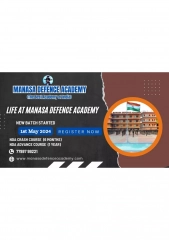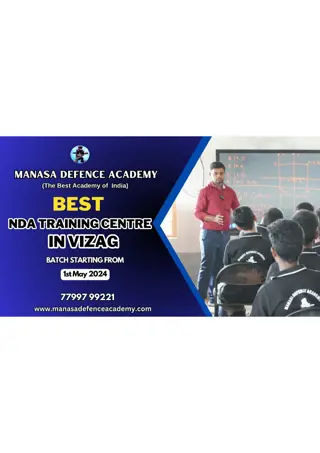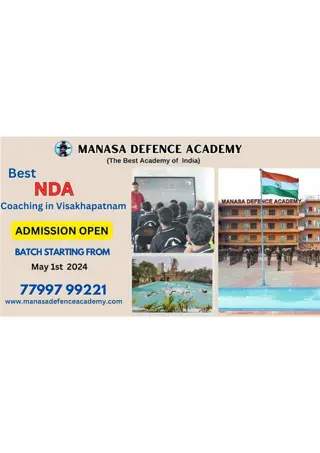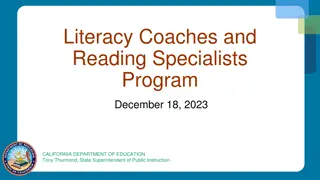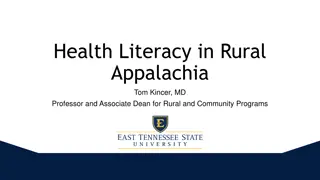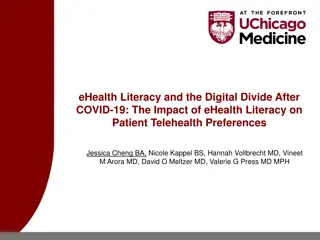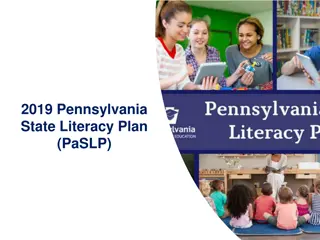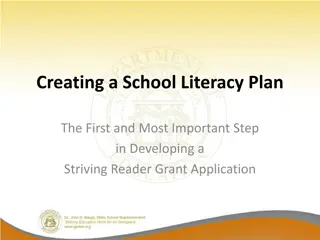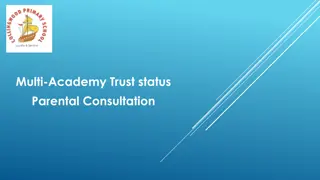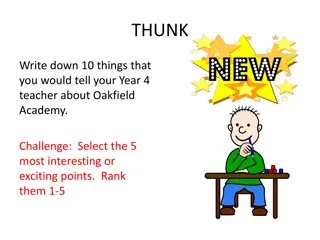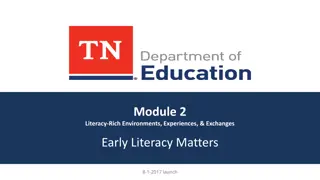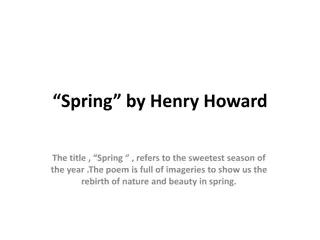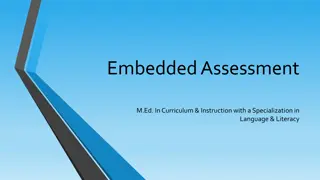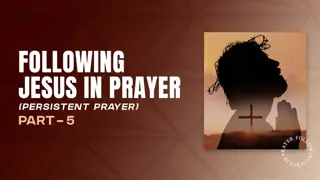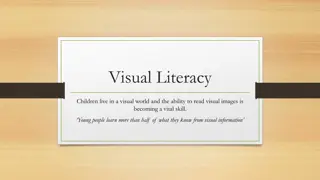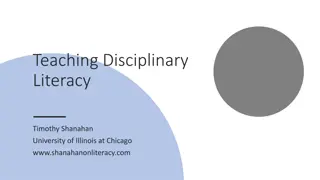
Ohio Science of Reading Courses Overview
Explore the details and requirements of Ohio's Science of Reading courses, designed to enhance educators' skills in literacy instruction. Discover pathways for professional development, training options, and resources available to support effective implementation.
Uploaded on | 0 Views
Download Presentation

Please find below an Image/Link to download the presentation.
The content on the website is provided AS IS for your information and personal use only. It may not be sold, licensed, or shared on other websites without obtaining consent from the author. If you encounter any issues during the download, it is possible that the publisher has removed the file from their server.
You are allowed to download the files provided on this website for personal or commercial use, subject to the condition that they are used lawfully. All files are the property of their respective owners.
The content on the website is provided AS IS for your information and personal use only. It may not be sold, licensed, or shared on other websites without obtaining consent from the author.
E N D
Presentation Transcript
This presentation contains examples and resource materials that are provided for the user s convenience. The inclusion of any material is not intended to reflect its importance, nor is it intended to endorse any views expressed, or products or services. These materials may contain the views and recommendations of the presenter as well as hypertext links, contact addresses and websites to information created and maintained by other public and private organizations. The opinions expressed in any of these materials do not necessarily reflect the positions or policies of the U.S. Department of Education or Ohio Department of Education and Workforce. The U.S. Department of Education and Ohio Department of Education and Workforce do not control or guarantee the accuracy, relevance, timeliness, or completeness of any outside information included in these materials. Mentions of specific programs or products in these examples are designed to provide clearer understanding and are not meant as endorsements. 3
GETTING THE MOST OUT OF OHIOS SCIENCE OF READING COURSES JEREMY LUKE Literacy Learning Specialist, Ohio Department of Education and Workforce - Jeremy.Luke@education.ohio.gov ROGER HOWARD Adolescent Literacy Specialist, State Support Team 3 Roger.Howard@escneo.org 4
LEARNING OBJECTIVES Participants in the session will be able to: Identify learning and resourcesfrom Ohio s Science of Reading Course to meet building and district staff training needs Evaluate current approaches to learning implementation to plan improvements Utilize key resources to guide the implementation of learning 5
TURN AND TALK Answer the following question with a neighbor (or two): How do educators at your district utilize professional learning in the Science of Reading in their instruction? 6
PROFESSIONAL LEARNING IN THE SCIENCE OF READING 7
REQUIREMENTS AND OPTIONS: OHIOS SCIENCE OF READING COURSE By June 30, 2025, all educators must be trained in the Science of Reading Educators may take a course developed by the Department or a similar training Eligible educators can receive a $400 or $1,200 stipend Seven course pathways are available based on role, grade band, and previous training 8
COURSE PATHWAYS Course pathways Pathway A: All K-5 teachers, intervention specialists, English learner teachers, reading specialists, instructional coaches Pathway B: Educators eligible for Pathway A who completed approved Dyslexia training Pathway C: All 6-12 English Language Arts teachers, intervention specialists, English learner teachers, reading specialists, instructional coaches Pathway D: 6-12 educators eligible for Pathway C who completed approved Dyslexia training Pathway E: 6-12 content teachers Pathway F: K-12 administrators Pathway G: Pre-kindergarten teachers, intervention specialists, reading specialists, instructional coaches 9
COURSE CONTENT Components of literacy: Phonemic Awareness, Phonics, Vocab, Fluency, Comprehension, Writing Instructional practices: Explicit and Systematic Literacy Systems: MTSS, Teaming, Decision Rules Assessment and Intervention: Screening, Diagnostic, Progress Monitoring Leading Literacy: Implementation, Scheduling, Building Systems 10
MODELS OF PROFESSIONAL DEVELOPMENT Joyce & Showers (1980, 2002) Professional Learning Impact on Knowledge Impact on Skill Impact on Practice Theory Theory + Modeling Theory + Modeling + Practice 10% 30% 60% 5% 20% 60% 0% 0% 5% Theory + Modeling + Practice + Coaching 95% 95% 95% Professional learning alone demonstrated no impact on classroom instruction! 11
OPTIMIZING PROFESSIONAL LEARNING 12
Determine Needs with Data Revise, Intensify, or Identify New Approach Deliver Professional Learning PROFESSIONAL LEARNING SHOULD BE A CYCLICAL PROCESS Reinforce with Coaching and Teams Support Assess Students Learning Outcomes Assess Implementation with Walkthroughs 13
QUALITY PROFESSIONAL LEARNING Typical Professional Learning Optimal Professional Learning Free standing Short-term Nonsystematic Infrequent Sit-and-forget Smattering Smorgasbord Aligned with district literacy plan Guided by carefully crafted learning objectives Modeling and practice embedded Collaboration and reflection Follow up and feedback (learning walks) Sustained connection between learning and implementation Turn and Talk: What elements of Typical and Optimal professional learning do you currently see in your building or district? 14
GUSKEYS FIVE LEVELS OF PROFESSIONAL LEARNING Level 1: Participants' Reactions Level 2: Participants' Learning Level 3: Organizational Support and Change Level 4: Participants' Use of New Knowledge and Skills Level 5: Student Learning Outcomes 15
REINFORCING LEARNING FROM THE COURSE Data Analysis: Use data to identify areas of need for learning Content: Revisit key modules and lessons Practice and Modeling: Coaches, teacher leaders, and peers demonstrate strategies and resource use Coach: Provide guidance, conversations, and feedback on implementation Document: Science of Reading Course Learning and Resource Guide 16
UTILIZING TEAM MEETINGS TO REINFORCE LEARNING Peer Coaching: Use team time to model, observe, and reflect together Alternate meetings: Provide time in one meeting to review lessons and time in the next meeting to discuss learning Discussion: Share Response Notebook entries Resource Bank: Gather and share tools and resources from the course 17
LEARNING WALKS Learning walks provide the opportunity for educators to: Observe high-quality implementation of learning and resources Receive and provide feedback on practice Plan and problem-solve during team time High Quality Learning Walks: Focus on a specific strategy or resource Are non-evaluative Link closely to previous professional learning Well-understood by all participants Handout: Learning Walk Template 18
IMPLEMENTING PROFESSIONAL LEARNING 19
ENSURING EFFECTIVENESS AND REFINING IMPLEMENTATION Evidence Based Practices - HQIM's (Ohio's Plan to Raise Literacy Achievement, Page 38) 21
USING IMPLEMENTATION SCIENCE 23 (Ohio's Plan to Raise Literacy Achievement, Page 37)
NATIONAL IMPLEMENTATION RESEARCH NETWORK (NIRN) TOOLS Tool: Initiative Inventory AI Hub Implementation Stages Planning Tool NIRN SISEP Video Series AI Hub 24
USING THE READING TIERED FIDELITY INVENTORY AS "ROAD MAP" FOR IMPLEMENTATION OF SOR Reading Tiered Fidelity Inventory (R-TFI) | TA Center 25
TIER ONE R-TFI ITEMS COMMON TO BOTH ELEMENTARY AND SECONDARY VERSIONS 27
R-TFI ITEMS FOR THE ADVANCED MTSS TIERS ARE IDENTICAL FOR BOTH ELEMENTARY AND SECONDARY VERSIONS 30
NON-NEGOTIABLES FOR EFFECTIVE MULTI-TIERED SYSTEMS OF SUPPORTS How-To-Build-An-Elementary-Master-Schedule-That-Unlocks- Opportunities-To-Raise-Achievement-and-Improve-Equity.pdf ImplementingMTSSinSecondarySchools_2022 _RC6_003.pdf 31
PROVIDING BOTH SYSTEMS-LEVEL COACHING AND INSTRUCTIONAL COACHING (Implementing Ohio's Plan to Raise Literacy Achievement, 2023) 32
THREE ACTIONS OF EFFECTIVE LEADERS How Principals Affect Students and Schools (Wallace Foundation, 2021) Intro to Science of Reading for Administrators 33
QUESTIONS? education.ohio.gov/LiteracyAcademy

